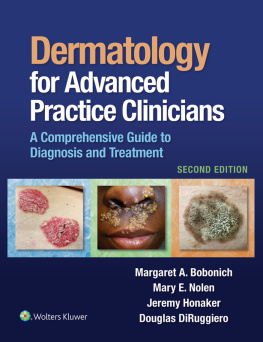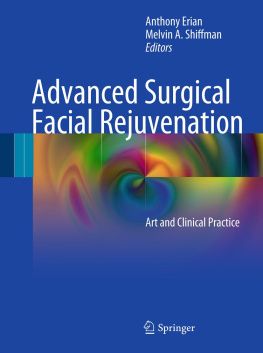A Compendium for Advanced
Aesthetics
A Guide for the Advanced or Master Aesthetician
Mary Nielsen
Table of Contents
Appendix A
Common Photosensitizing Medications And Herbal Supplements
Appendix B
Common Forms in Advanced Aesthetics
Appendix C
Links to Advanced Aesthetic Professional Resources, Manufacturers
Appendix D
Answers to Review Questions
1.History of Advanced Aesthetics Licensure
A wild west atmosphere existed in the early 2000 reach extended beyond the training provided in basic aesthetic school. Unregulated medical spas opened and thrived as our national culture embraced celebrity looks and youthfulness as a prized value. A small chain of medical spas in the Portland, Oregon area racked up over 750 complaints to the Oregon Attorney General in 2013 for fraudulent claims, injuries, and financial mismanagement. This company closed and left the state overnight, leaving clients who were injured from treatments performed by poorly-trained technicians, as well as thousands of dollars in pre-paid services that were unable to be redeemed. Without regulation, the consumer was at risk.
The career path for aestheticians has been a journey with increasing growth and levels of professionalism. Aesthetics has moved from the back room of the beauty salon to the forefront of aesthetic medicine. It deserves its own focused training and education, beyond what is taught in basic aesthetics.
What is scope of practice?
Each state has its own scope of aesthetics practice. What is scope of practice? A simple answer is that scope of practice is what you are legally allowed to do as a licensed professional in your state. Every state is different. There are no national regulations for aesthetics. Some states have broader interpretations for what an aesthetician can do. Some states have a very narrow focus.
However, all state regulations have not kept up with technology. As professional skin-care treatments began a shift to medical aesthetics in the late 1990s, states recognized that a second tier of licensure was needed to clarify scope of practice issues and protect the consumer. Utah was the first in the country to add a Master Esthetics licensure after Basic Esthetics licensure in 2001.
The advanced aesthetics education includes more in-depth training in skin conditions and disorders and a broader understanding of skin histology, physiology, and anatomy. Each state with an advanced licensure has its own educational requirements, but most include advanced chemistry, dermatology, and plastic surgery terminology, and advanced exfoliation, both mechanical and chemical. If the scope of practice includes advanced body and facial treatments, it will often include energy devices such as lasers, IPL, and radio frequency.

In each state, the legislation required in creating this second tier of licensure involved networking between states professional boards, including boards of medicine, boards of nursing, dentistry, naturopaths, and boards of massage therapists to define a specific scope of practice that does not infringe on the skills of other professionals. Virginia master aestheticians focus is on chemical exfoliation and does not include the use of energy devices. Utah and Washington master aestheticians must work under the direction of a medical director. Oregon States advanced aesthetician scope of practice language specifies seven different non-ablative treatments that an advanced aesthetician can perform, including laser hair removal, skin rejuvenation, photo rejuvenation, dyschromia reduction, body contouring, cellulite reduction, and tattoo removal. Oregon advanced aestheticians can practice independently with a collaborative agreement in place with a medical provider, who will see clients on request for a consultation.

An Example of a Clinical Treatment Room
There is also no legal licensure for a medical aesthetician in the United States. It is not a legally recognized professional term. Using the title can be considered fraud in some states. You should represent yourself using the professional title recognized in your state for licensure. If you have attended special training, you can add a tag line about that training on your business card. For example, Specializing in medical aesthetics or Trained in oncology skin care. |
Aestheticians scope of practice needed redefining and clarification, and the advanced aesthetician license is a fitting choice for skin-care professionals who desire professional elevation and options beyond elemental skin care. Technological advances with devices and equipment and skin-care innovations are expanding rapidly and the advanced aesthetician has fulfilling career options ahead.
Review Questions
- What is scope of practice?
- What a person is legally allowed to do as a licensed professional
- What a physician, nurse, or nurse practitioner can do while in the hospital
- A legal term for performing advanced aesthetic treatments
- A medical aesthetician is
- An advanced aesthetic licensure in Utah and Washington state
- Not a legally recognized licensure in the United States
- An advanced licensure for a nurse specializing in aesthetics
- A person who wants an advanced aesthetic license must
- First complete basic aesthetics licensure
- Qualify through a national licensing program
- Have employment in a physicians office
- A person who has an advanced aesthetics license may have a scope of practice that permits them to work in a
- Plastic surgery office or dermatology office, assisting with chemical peels, body contouring, and tattoo removal
- Medical spa, performing advanced services, such as laser hair removal and photo rejuvenation treatments
- Both A and B
Aesthetics and esthetics are both correct spellings with the same meaning. Where a formal program reference is used, the spelling used by the state will be applied.
http://www.rules.utah.gov/publicat/code/r156/r156-11a.htm
. Accessed February 27, 2017.
. Accessed February 27, 2017.
. Accessed February 27, 2017.
. Accessed February 27, 2017.
2.Health Information Portability and Accountability Act Documentation Requirements
HIPAA stands for Health Information Portability and Accountability Ac t. It went into effect in 1996 and standards were updated in 2003. This legislation sets national standards for the privacy of health-care information. HIPAA regulations require administrative, physical, and technical safeguards to client information. Facilities are required to have policies and procedures to ensure client confidentiality. All staff and others who may have exposure to client information need to understand and comply with HIPAA guidelines.
Privacy Officer Required
Facilities must have an appointed Privacy Officer. The Privacy Officer is responsible for policies and procedures, ensuring confidentiality and consequences for those who do not follow the confidentiality guidelines. The Privacy Officer is responsible for educating staff on the policies and procedures and the importance of adhering to them. Other duties of the Privacy Officer include instigating a process for handling violations of confidentiality, ensuring there is no retaliation against a staff member who reports a violation, and taking appropriate action to minimize against an infringement of confidentiality that could potentially harm a client.
Next page











